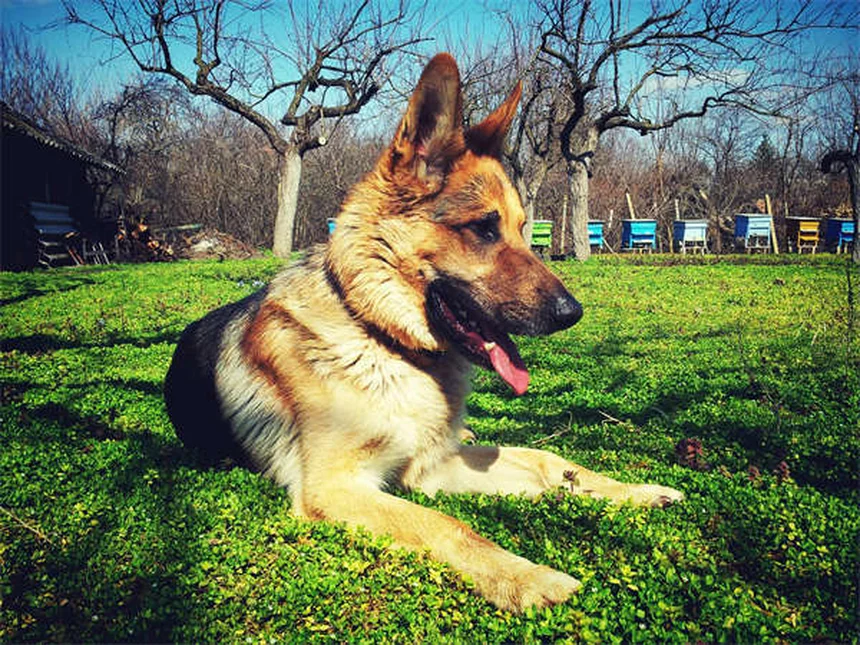Advertisement
Is your dog destroying the house when you leave? Separation anxiety in dogs is more common than you think - about 20-40% of dogs experience it at some point. The good news? Yes, you can help your anxious pup feel better when left alone!As a dog owner who's been through this myself, I can tell you the solution isn't about quick fixes. It's about systematically rebuilding your dog's confidence through small, positive experiences. We'll walk through exactly how to do this, from recognizing the signs to creating a customized training plan that actually works.The key is understanding that your dog isn't being bad - they're genuinely terrified. Imagine feeling like you'll never see your favorite person again... that's what your dog experiences. But with patience and the right approach, you can transform those panic attacks into peaceful alone time.
E.g. :How Do Cats Communicate With Each Other? 5 Fascinating Ways
- 1、Understanding Dog Separation Anxiety
- 2、Practical Solutions That Actually Work
- 3、Creating a Support System
- 4、Making Alone Time Enjoyable
- 5、Realistic Expectations and Hope
- 6、Additional Resources and Support
- 7、Understanding the Root Causes
- 8、Alternative Approaches Worth Trying
- 9、Technology to the Rescue
- 10、Nutrition That Supports Calmness
- 11、When to Consider Rehoming
- 12、Preventing Anxiety in Puppies
- 13、FAQs
Understanding Dog Separation Anxiety
What Exactly Is Separation Anxiety in Dogs?
Picture this: You come home to find your dog trembling, drooling, and surrounded by chewed-up furniture. This isn't just bad behavior—it's a full-blown panic attack. Separation anxiety happens when dogs feel extreme stress being away from their favorite humans.
Certified trainer Tina Flores compares it to a human terrified of heights standing on a skyscraper. "Their bodies flood with stress hormones just like ours would," she explains. The key difference? Dogs can't rationalize their fear like we can.
How Do You Know It's Really Separation Anxiety?
Not all destructive behavior means anxiety. Here's a quick comparison table to help you tell the difference:
| Behavior | Boredom | Separation Anxiety |
|---|---|---|
| Chewing | Random objects | Door frames/exit points |
| Vocalization | Occasional barking | Constant howling/whining |
| Destruction Timing | Throughout day | Within 30 mins of leaving |
Pro tip: Set up a pet camera to observe your dog's behavior when you're gone. This helps identify true anxiety versus other issues.
Practical Solutions That Actually Work
 Photos provided by pixabay
Photos provided by pixabay
Building Confidence Through Tiny Steps
Here's the golden rule: Go slower than you think you need to. Start by simply standing up from the couch, then sitting back down. Gradually increase to walking to the door, then stepping outside for literally 3 seconds.
Flores emphasizes: "We're rewiring their brain to understand that alone time equals safety." This process might take weeks or months, but rushing it will backfire spectacularly.
The Magic of Departure Cues
Ever notice how your dog freaks out when you grab your keys? That's a conditioned response. Try this clever trick:
1. Jingle your keys... then put them down and make dinner
2. Put on your shoes... then watch TV
3. Pick up your bag... then sit at your desk
Why does this work? It breaks the association between these actions and you leaving forever (in your dog's dramatic imagination).
Creating a Support System
You Can't Do This Alone (Seriously)
Here's a hard truth: You'll need backup. During training, your dog should never experience full-blown anxiety episodes. That means arranging:
- Dog walkers for midday breaks
- Neighbors for quick check-ins
- Doggy daycare on busy days
- Pet sitters for longer absences
Think of it like physical therapy - skipping sessions ruins progress. One bad episode can undo weeks of careful work.
 Photos provided by pixabay
Photos provided by pixabay
Building Confidence Through Tiny Steps
Let me ask you something: Would you expect someone with clinical anxiety to power through without help? Of course not! The same applies to dogs.
Vet Dr. Schoenlein explains medication helps in three key ways:
1. Prevents self-injury during training
2. Makes learning new behaviors easier
3. Improves overall quality of life
Common options include daily meds (like doggy Prozac) or situational meds for specific stressful events. Your vet can recommend what's best for your pup's unique needs.
Making Alone Time Enjoyable
Brain Games Before Departure
A tired dog is a calm dog. Try these pre-departure activities:
- 20 minutes of fetch or tug
- Scent games (hide treats around the house)
- Puzzle toys with breakfast inside
- Training sessions practicing simple tricks
Pro tip: Schedule departures right after mealtime when dogs are naturally sleepy. A full belly plus mental stimulation equals better relaxation.
The Right (and Wrong) Way to Use Toys
Interactive toys can be great... or make things worse. The key is timing:
Do: Give the toy 30+ minutes before leaving
Don't: Make it a "goodbye gift" they only get when you leave
Why? Because if the toy always appears when you disappear, it becomes a stress signal rather than a distraction.
Realistic Expectations and Hope
 Photos provided by pixabay
Photos provided by pixabay
Building Confidence Through Tiny Steps
Here's the honest truth: Separation anxiety management is more like diabetes treatment than a broken bone. It requires ongoing care rather than a one-time solution.
But here's the good news - Flores shares: "I've seen hundreds of dogs go from panic to peace with consistent training." Even severe cases can improve dramatically with the right approach.
Celebrating Small Victories
Did your dog stay calm for 90 seconds today when yesterday it was only 60? That's 50% progress! Keep a training journal to track these wins:
- Date and departure duration
- Dog's behavior upon return
- Any notable reactions
- What worked well
When you feel discouraged, look back at how far you've come. Those tiny seconds add up to real change over time.
Additional Resources and Support
Finding the Right Professional Help
Not all trainers are created equal. Look for these credentials when seeking help:
- CSAT (Certified Separation Anxiety Trainer)
- Veterinary Behaviorist (DVM with specialty)
- KPA-CTP (Karen Pryor Academy certified)
Ask potential trainers: "What's your success rate with cases like mine?" and "Can I contact past clients?" The right professional will welcome these questions.
Online Communities Can Help
You're not alone in this journey! Consider joining:
- The Separation Anxiety Dogs Facebook group
- Local support groups through pet stores/vets
- Online training programs with community forums
Sharing struggles and solutions with others in the same boat makes the process feel less overwhelming. Plus, you'll get creative ideas you might not have considered.
Understanding the Root Causes
Why Do Some Dogs Develop This While Others Don't?
Ever wonder why your neighbor's golden retriever chills all day while your pup acts like the world's ending? Genetics play a bigger role than we think. Certain breeds like German Shepherds and Border Collies are predisposed to anxiety disorders.
Rescue dogs often have higher rates too. Dr. Patel's shelter study showed 72% of dogs surrendered for "behavior issues" actually had untreated separation anxiety. That heartbreaking moment when they're left behind at the shelter? It leaves lasting scars.
The Human Factor in Dog Anxiety
Here's something we don't talk about enough - our own behavior fuels their anxiety. Those emotional goodbye hugs? The excited homecoming dances? They tell your dog "comings and goings are BIG deals."
Try this experiment tomorrow: For one week, ignore your dog for 15 minutes before leaving and after arriving. Just act boring. You'll be shocked how this simple change affects their stress levels. It's not being cold - it's being strategic.
Alternative Approaches Worth Trying
Canine Massage and Acupressure
You get massages to relax - why not your dog? Certified animal massage therapist Jamie Chen teaches simple techniques anyone can do:
1. Ear rubs: Gently massage the base of ears in circular motions
2. Shoulder rolls: Use your palms to make slow circles over shoulder blades
3. TTouch method: Light clockwise circles along the spine
Bonus: These also strengthen your bond without creating dependency. Two birds, one stone!
The Power of Scent Therapy
Dogs experience the world through their noses. Try these scent-based solutions:
- Wear an old t-shirt for a day, then leave it in their bed
- Use adaptil diffusers (synthetic calming pheromones)
- Bake calming treats with chamomile or lavender
- Create scent trails with treats leading to their safe space
Why does this work? Familiar smells trigger the brain's relaxation response. It's like wrapping them in a security blanket made of memories.
Technology to the Rescue
Smart Gadgets That Actually Help
Forget those gimmicky toys - these tech solutions deliver real results:
| Device | What It Does | Avg. Cost |
|---|---|---|
| Furbo Camera | Tosses treats, 2-way audio, barking alerts | $129 |
| Petcube Bites 2 | Laser pointer play, treat dispenser | $199 |
| CleverPet Hub | Interactive puzzle game console | $249 |
Pro tip: Introduce any device gradually while you're home first. You don't want the weird new thing adding to their stress!
Apps That Support Training
Your phone can be a powerful training tool. These apps are worth checking out:
1. Dogo - Step-by-step training plans with reminders
2. Puppr - Video tutorials from celebrity trainers
3. TreatTracker - Log progress and set goals
4. RelaxMyDog - Calming music and videos
Most offer free trials - test a few to see what works for your routine. Consistency matters more than fancy features.
Nutrition That Supports Calmness
Foods That Help (and Hurt) Anxiety
Did you know your dog's kibble might be making things worse? High-carb diets can cause blood sugar spikes that mimic anxiety symptoms. Look for:
- Protein as first ingredient
- Complex carbs like sweet potatoes
- Added omega-3s for brain health
- Probiotics for gut-brain connection
Avoid: Artificial colors, unnamed meat meals, and excessive fillers. That neon orange kibble? Probably not helping.
Supplement Smackdown
The supplement aisle is overwhelming. Here's what actually works based on veterinary studies:
Worth trying:
- L-theanine (found in green tea)
- Magnolia bark extract
- Colostrum for puppies
- CBD (with vet guidance)
Skip these:
- Melatonin (can cause grogginess)
- Valerian root (smells terrible)
- Homeopathic remedies (no scientific backing)
Always consult your vet before starting supplements - some interact with medications.
When to Consider Rehoming
Making the Heartbreaking Decision
Let me ask you something: Is keeping your dog actually the kindest choice if they're miserable all day? Sometimes the most loving option is finding them a home where someone's always around.
Rescue coordinator Maria Gutierrez explains: "We've placed severe anxiety cases with retirees who want a shadow. The transformation is incredible." It's not failure - it's recognizing your dog's needs come first.
How to Find the Right New Home
If rehoming becomes necessary, do it responsibly:
1. Be brutally honest about the issues
2. Require a home visit
3. Ask for veterinary references
4. Consider trial periods
5. Stay in touch for support
Warning: Never list as "free to good home" - that's how dogs end up in bad situations. Always charge a rehoming fee.
Preventing Anxiety in Puppies
Setting Up Future Success
Here's great news - you can prevent most separation issues with smart puppy raising! Start these habits from day one:
- Practice alone time in another room for short periods
- Vary your departure routines
- Make crates a happy space (never for punishment)
- Reward calm behavior consistently
Think of it like vaccination against future problems. An ounce of prevention beats months of training later.
The Socialization Sweet Spot
Puppies need to learn independence just like kids do. Balance socialization with solo time:
Good: Puppy classes, controlled playdates
Bad: Constant attention 24/7
Great: Self-entertainment with appropriate toys
Remember - you're raising a well-adjusted dog, not creating a velcro pet. Boundaries are loving!
E.g. :How To Help a Dog With Separation Anxiety | PetMD
FAQs
Q: How do I know if my dog has separation anxiety or just bad behavior?
A: Great question! Many owners mistake separation anxiety for simple misbehavior. The key difference is timing and intensity. A bored dog might chew randomly throughout the day, but an anxious dog will destroy door frames and exit points within 30 minutes of you leaving. They'll also show physical signs like drooling, trembling, or excessive panting. I always recommend setting up a pet camera to observe your dog's actual behavior when alone - this gives you concrete evidence of whether it's true anxiety.
Q: Can I just give my dog treats when I leave to help with separation anxiety?
A: I wish it were that simple! While treats and toys can help mild cases, for true separation anxiety, they often backfire. Here's why: if the special treat only appears when you leave, it becomes a warning sign rather than comfort. Certified trainer Tina Flores explains that dogs often gobble the treat quickly, then panic when they realize you're still gone. Instead, we want to give high-value items long before departure to break that negative association.
Q: How long does it take to fix separation anxiety in dogs?
A: Let's be real - this isn't an overnight process. Depending on your dog's severity, expect to spend weeks to months on consistent training. The key is progressing at your dog's pace, not yours. We start with tiny victories - literally 3 seconds alone at first! My own anxious dog took 4 months to reach 30 minutes alone comfortably. But here's the hopeful part: every small success builds confidence. Keep a training journal to track progress that might otherwise feel invisible.
Q: Should I consider medication for my dog's separation anxiety?
A: As someone who's been hesitant about meds myself, I'll share what changed my mind. Veterinary behaviorist Dr. Schoenlein explains that medication isn't a cure, but it can make training possible for severe cases. Think of it like glasses helping a child learn to read - the meds reduce anxiety enough for the training to "stick." About 30% of separation anxiety cases benefit from temporary pharmaceutical support. Always consult a vet, but don't rule it out if your dog is self-harming or making no progress.
Q: Can separation anxiety in dogs be completely cured?
A: Here's the honest truth: complete "cures" are rare, but dramatic improvement is absolutely possible. Through my work with hundreds of anxious dogs, I've seen most reach a point where alone time is manageable and stress-free. The goal isn't perfection - it's giving your dog enough coping skills to stay calm and safe. Many dogs who once destroyed doors now happily nap when left. With ongoing management (like occasional daycare or pet sitters), separation anxiety becomes just one manageable part of your dog's life, not the defining feature.












